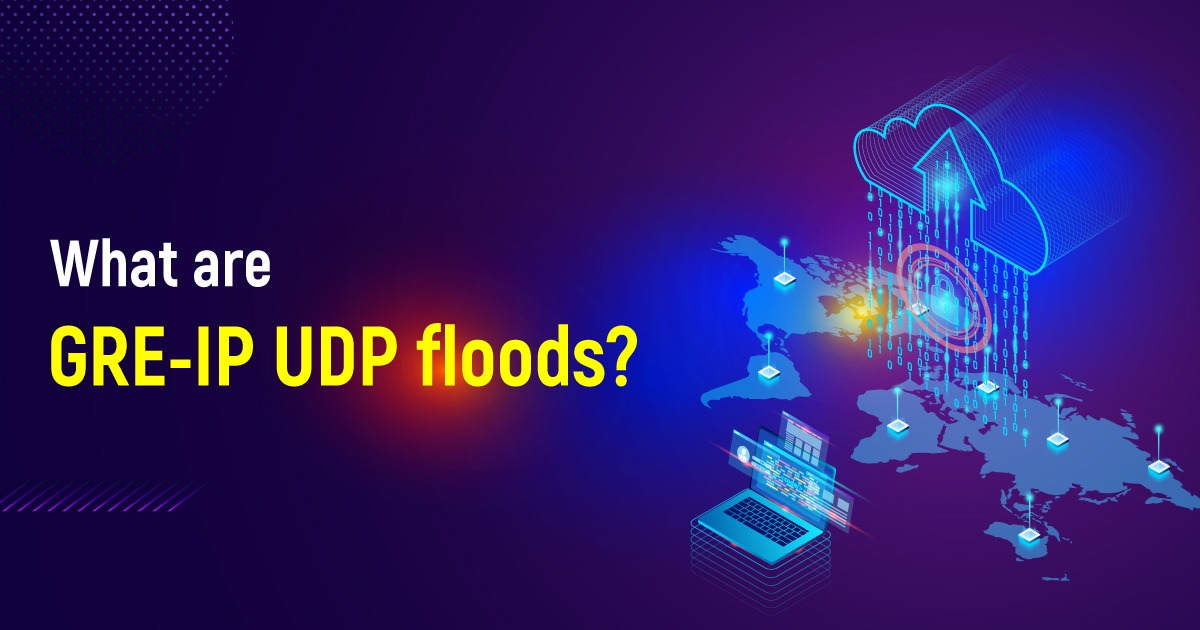Generic Routing Encapsulation (GRE) is a tunneling protocol that encapsulates various network protocols within Internet Protocol (IP) packets. User Datagram Protocol (UDP) is a lightweight transport protocol used for sending data over IP networks. Both protocols are fundamental to network communications.
Amplification attacks exploit the characteristics of certain protocols, like GRE-IP and UDP, to amplify the volume of traffic directed towards a victim’s system. In GRE-IP UDP floods, attackers forge the source IP address and send a small GRE-IP or UDP packet to multiple vulnerable devices or servers on the network. These devices respond with much larger responses, flooding the victim’s infrastructure with a massive surge of data.
Working of GRE-IP UDP Floods
During a GRE-IP UDP flood, attackers leverage vulnerable or misconfigured devices, such as routers, servers, or IoT devices, that support GRE or UDP protocols. By spoofing the victim’s IP address, the attacker sends a flood of GRE-IP or UDP packets to these devices, which, in turn, respond with significantly larger packets directed towards the victim. This amplification effect results in an overwhelming amount of traffic reaching the victim’s infrastructure, potentially causing service disruptions or complete system failure.
Risks and impacts of GRE-IP UP Floods
GRE-IP UDP floods pose significant risks and can have severe consequences for targeted systems and networks:
Network Congestion:
The massive surge of traffic generated during an attack can congest the victim’s network, leading to service degradation and impeding legitimate users’ access to critical resources.
Denial of Service (DoS):
Successful GRE-IP UDP floods can overload the victim’s system, resulting in a denial of service. This can lead to financial losses, reputational damage, and customer dissatisfaction.
Resource Exhaustion:
The excessive traffic generated during an attack can exhaust the victim’s server resources, including bandwidth, CPU, and memory. This can severely impact the system’s ability to function properly, causing performance degradation or system crashes.
Collateral Damage:
GRE-IP UDP floods can cause collateral damage by impacting other devices and services sharing the same network infrastructure. This can lead to widespread disruptions and additional costs for organizations.
Mitigation strategies to prevent GRE-IP UDP Floods

To defend against GRE-IP UDP floods, organizations can adopt various preventive measures:
Access Control Lists (ACLs):
Implement ACLs on routers and firewalls to filter and block suspicious GRE or UDP traffic. Configure rules to allow only necessary traffic and deny unauthorized requests.
Rate Limiting:
Set up rate limiting mechanisms to restrict the number of GRE-IP or UDP packets allowed per second. This can help prevent amplification and reduce the impact of floods.
Traffic Monitoring:
Deploy network traffic monitoring tools to detect and analyze anomalous patterns, allowing for early detection of GRE-IP UDP floods. This enables organizations to respond promptly and implement countermeasures.
Patching and Updates:
Regularly update and patch network devices and servers to address known vulnerabilities that could be exploited for amplification attacks. Stay informed about security advisories and follow vendor recommendations.
Conclusion
GRE-IP UDP floods pose a significant threat to the security and availability of networks and systems. It is crucial for organizations to understand this vulnerability and take proactive measures to mitigate the risks. By implementing access controls, rate limiting mechanisms, deploying traffic monitoring tools, and maintaining regular patching and updates, organizations can fortify their defenses against GRE-IP UDP floods, enhancing overall cybersecurity resilience.












